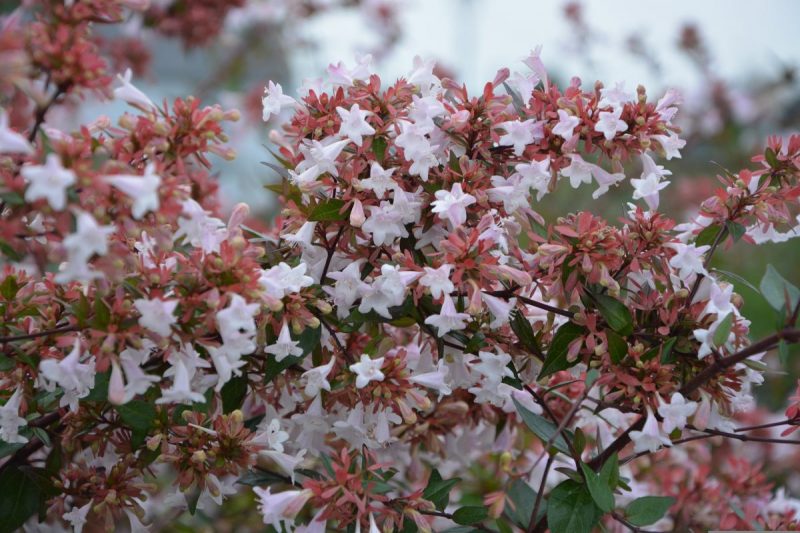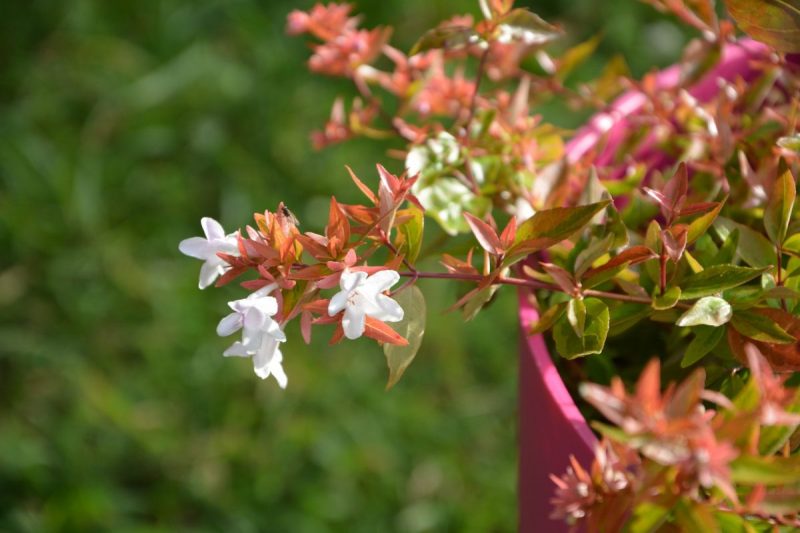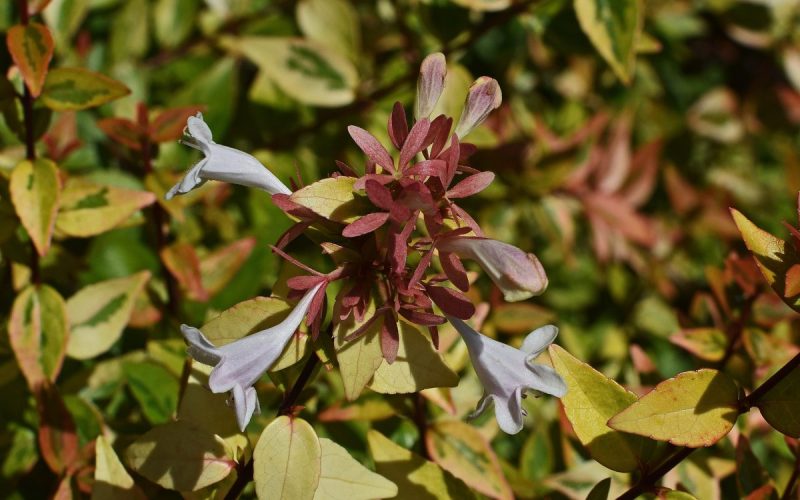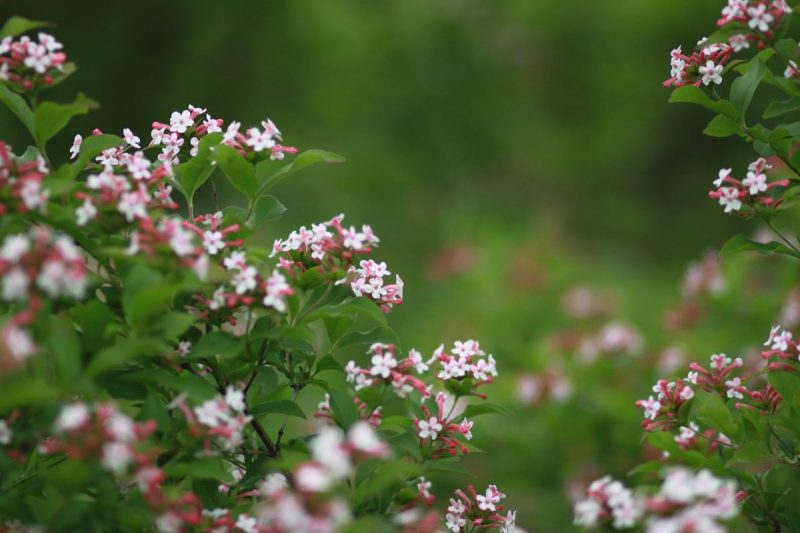Abelia, planting guide and care work

Abelia (Abelia spp.) is a shrub that is part of the Abelia genus, Caprifoliaceae family – a genus that includes approximately 30 species of shrubs.
Abelia is a decorative shrub with flowers, with deciduous leaves, originally from East Asia and northern Mexico. It stands out for its thin branches, which bear oval, slightly pointed, dark green leaves, that change their shade to yellow-brown or shades of red and orange, with the arrival of autumn. The flowers are bell-shaped, found in shades of white or light pink, pleasantly scented. Unlike other ornamental shrubs with flowers, Abelia has a long flowering period, from spring to autumn. Abelia can be grown outdoors, directly in the garden or in flowerpots.
Abelia – species and varieties
- Abelia × grandiflora: it is the most popular variety, found in many regions, with a warmer or cooler climate, having a long flowering period. It has glossy green leaves and white, fragrant flowers that appear on new growths at the end of spring;
- Abelia x grandiflora ‘kaleidoscope’: it is famous for its foliage that changes color with the arrival of autumn. The variegated leaves have a golden-yellow hue in the spring, then turn red or orange in the fall. The flowers are small, white;
- Abelia x chinensis ‘Rose Creek’: the green and glossy leaves acquire a bronze hue in autumn. The branches are purple in color and bear pink flowers that turn to white.



Environmental conditions
Light. It can be grown both in direct sunlight and in partial shade. Light positively influences the appearance of the foliage and the flowering capacity. In areas with hot summers, it is recommended to cultivate the plant in places where in the afternoon it can benefit from a light shade.
Temperature. Depending on the variety, it can tolerate temperatures up to -10 -15 ℃.
Soil. Abelia prefers fertile soils, rich in organic matter and well drained. It grows and develops optimally on a soil with slightly acidic pH.
Care – Abelia
Watering. The young plants need to be watered regularly, so that the soil is kept damp. As for mature plants, they can tolerate short periods of drought, but in hot summers, it is important to provide them with adequate humidity, so that the soil does not dry out completely before watering again.
Fertilizing. Abelia reacts positively to the application of fertilizers. Slow-release fertilizers can be applied in spring or special fertilizers for flowering plants, regularly, during the flowering period.
Recommended products
-
You can find products on a different store
Change Store -
You can find products on a different store
Change Store -
You can find products on a different store
Change Store -
You can find products on a different store
Change Store -
You can find products on a different store
Change Store -
You can find products on a different store
Change Store -
You can find products on a different store
Change Store -
You can find products on a different store
Change Store -
You can find products on a different store
Change Store -
You can find products on a different store
Change Store -
You can find products on a different store
Change Store -
You can find products on a different store
Change Store -
You can find products on a different store
Change Store -
You can find products on a different store
Change Store -
You can find products on a different store
Change Store -
You can find products on a different store
Change Store -
You can find products on a different store
Change Store -
You can find products on a different store
Change Store -
You can find products on a different store
Change Store -
You can find products on a different store
Change Store -
You can find products on a different store
Change Store -
You can find products on a different store
Change Store -
You can find products on a different store
Change Store -
You can find products on a different store
Change Store
Propagation. Occasional pruning encourages new growths and gives the shrub a pleasant appearance. It can be carried out at the end of winter or at the beginning of spring, to avoid cutting new growths. Likewise, diseased, dry or wrongly grown branches should be removed.
Recommended products
-
You can find products on a different store
Change Store -
You can find products on a different store
Change Store -
You can find products on a different store
Change Store -
You can find products on a different store
Change Store -
You can find products on a different store
Change Store -
You can find products on a different store
Change Store -
You can find products on a different store
Change Store -
You can find products on a different store
Change Store -
You can find products on a different store
Change Store -
You can find products on a different store
Change Store -
You can find products on a different store
Change Store -
You can find products on a different store
Change Store -
You can find products on a different store
Change Store -
You can find products on a different store
Change Store -
You can find products on a different store
Change Store -
You can find products on a different store
Change Store -
You can find products on a different store
Change Store -
You can find products on a different store
Change Store -
You can find products on a different store
Change Store -
You can find products on a different store
Change Store -
You can find products on a different store
Change Store -
You can find products on a different store
Change Store -
You can find products on a different store
Change Store -
You can find products on a different store
Change Store
Propagation. It can be propagated by cuttings, harvested in spring. Abelia can also be propagated by seeds, but following this procedure, the young plants will not keep all the characteristics of the mother plant.
Planting. It can be planted in spring or autumn, when the temperatures are positive and the soil is not frozen.
Immediately after planting, it is recommended to administer a fertilizer that stimulates the formation of the roots. These fertilizers help the plant to adapt more easily to the new conditions and to overcome the period of stress.
Recommended products
-
You can find products on a different store
Change Store -
You can find products on a different store
Change Store -
You can find products on a different store
Change Store -
You can find products on a different store
Change Store -
You can find products on a different store
Change Store -
You can find products on a different store
Change Store -
You can find products on a different store
Change Store -
You can find products on a different store
Change Store -
You can find products on a different store
Change Store -
You can find products on a different store
Change Store -
You can find products on a different store
Change Store -
You can find products on a different store
Change Store -
You can find products on a different store
Change Store -
You can find products on a different store
Change Store -
You can find products on a different store
Change Store -
You can find products on a different store
Change Store -
You can find products on a different store
Change Store -
You can find products on a different store
Change Store -
You can find products on a different store
Change Store -
You can find products on a different store
Change Store -
You can find products on a different store
Change Store -
You can find products on a different store
Change Store -
You can find products on a different store
Change Store -
You can find products on a different store
Change Store
Diseases and pests
Abelia is a plant resistant to the attack of pests and diseases. However, powdery mildew and aphids can sometimes be a problem.
Additionally:
- The rich foliage and the absence of flowers are often an effect of using fertilizers with a high nitrogen content;
- Excessive watering and poor water drainage can lead to root rot. As a result, the leaves will turn yellow, and the appearance of the plant will deteriorate;
- In some regions with a warmer climate, certain Abelia species keep their leaves during the winter.















































































































































































































































































































































































































































